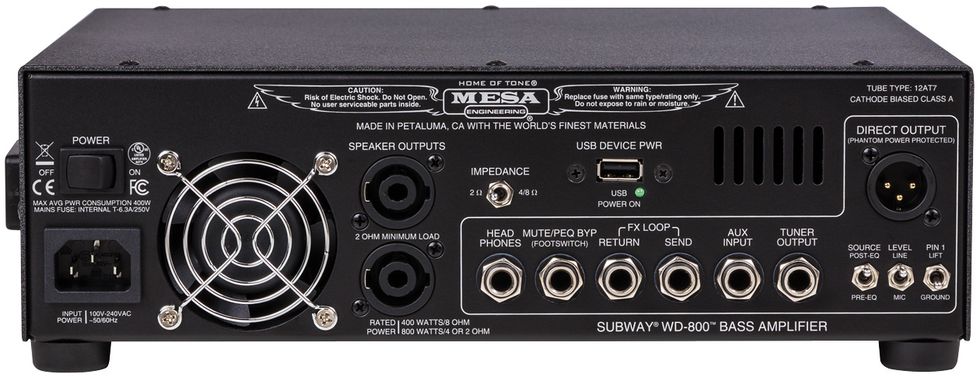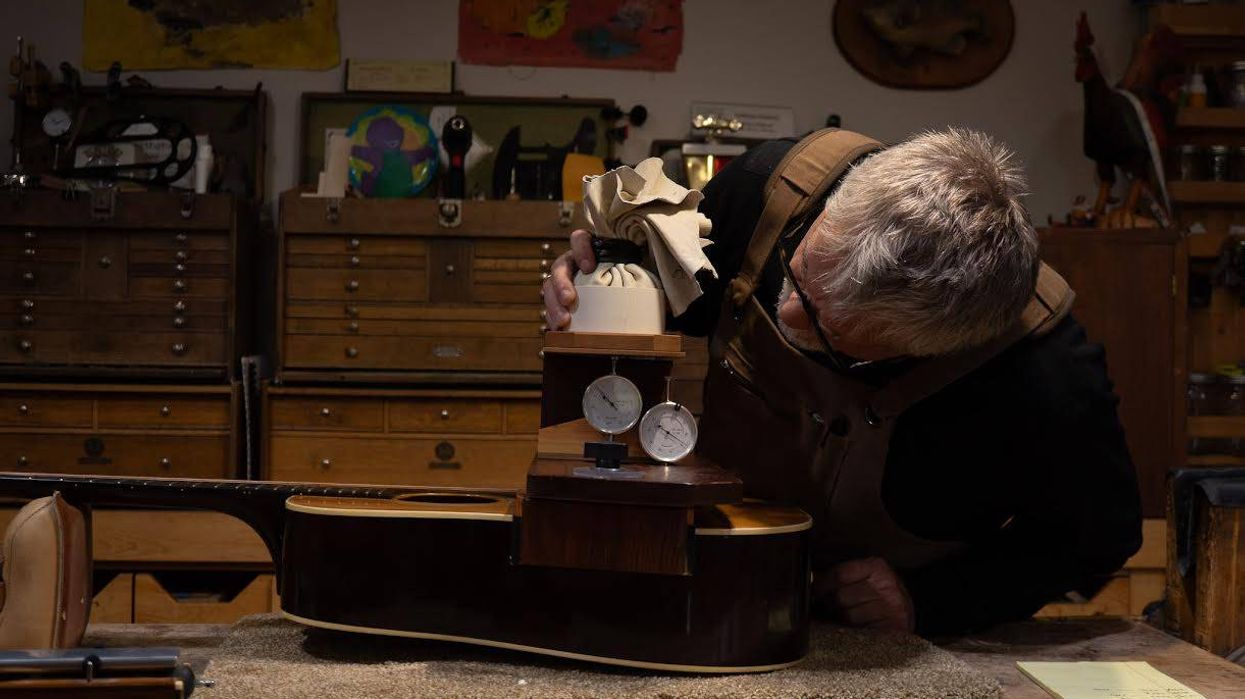Recorded direct into Avid Mbox into Logic X. Mesa/Boogie 1x15 cab miked with an Audio-Technica AE5400. Direct from head and mic balance split 50/50.
Clip 1: Recorded with Sadowsky Vintage PJ 5, (reverse P). Amp settings set flat except for passive mid at 10 o’clock. Power damping set to low.
Clip 2: Recorded with Music Man StingRay 5 fretless with piezo pickup. Amp settings set flat except for passive mid at 10 o’clock and 350 Hz frequency boosted to 1 o’clock. Power damping set to high.
RatingsPros:Versatility, road-worthiness, rear-panel features, tube tone. Cons: Might be somewhat difficult to navigate for players accustomed to simpler amps. Street: $999 Mesa/Boogie Subway WD-800 mesaboogie.com | Tones: Ease of Use: Build/Design: Value: |
Mesa/Boogie has probably made their biggest mark over the years with their guitar amps, but Mesa’s bass offerings have been providing us low-enders with a wide and respected variety of options and models since the company’s inception. The hallmark of their bass amps has been a strong midrange character that many players have grown to love. And while some other large bass-amp manufacturers tout rigs that offer transparency, much like an amplified clean DI signal, Mesa has never been shy about doing for bassists what they’ve done so successfully for guitarists: offer character, and lots of it. A few years ago, the company introduced the lightweight and surprisingly clean-sounding Subway D-800, which effectively became the beginning of a growing line of lightweight bass gear. More recently, Mesa unveiled the decked-out Subway WD-800, which boasts a 12AT7-powered preamp as one of its more significant new features. Spoiler alert: This new rig absolutely sounds just like a Mesa, and that’s a good thing.
Familiar Face
My expectations for the WD-800 were unusually high. Why? I’ve had plenty of experience using the company’s D-800 amp since it was released, both on the road and in the studio. When I first unpacked the amp from its included carrying bag with an external pocket for cables (nice touch), the look and feel of the chassis felt very familiar. In fact, the size and weight specs of the WD-800 are just slightly larger than they are for the D-800.
The increased height of the WD-800 helps accommodate the three parametric midrange-frequency selection controls, which are located directly above the boost/cut dials for the corresponding frequencies. The tone-shaping section might appear almost dazzling to bassists accustomed to meat-and-potatoes amplifiers, because in addition to the cluster of midrange controls, there are dials for bass, passive mid, treble, high-pass filter, and power-amp damping. For players who may have thought the D-800 didn’t offer enough tone-shaping possibilities, well, here you go.
Blinded Me with Science
I’ll quickly dive into what these controls do, since some of them are not commonplace. The high-pass filter comes in handy when using high drive tones or playing at loud volumes to protect a speaker cabinet from excessive low end. The passive-mid control has a different symmetry and response than the parametric EQ section, since it controls more frequencies at once.
On the far-right side, the power-amp damping control has three different settings: low, medium, and high. A simplified explanation would be that a lower damping setting feels looser or more “bloomy” in the bottom end, while a higher damping has a tighter low end or more immediate feeling. As a very general rule, Mesa recommends trying a higher damping setting with ported cabinets and a lower damping setting for sealed cabinets. This control subtlety affects the feel of the amp more than the tone of the amp, so experimentation is key to dialing in what you prefer.
The rear panel houses all the usual suspects, and then some. It shares some key features with the D-800 and the D-800+—namely the impedance switch from 4/8 ohm to 2 ohm, DI pre/post EQ switch, tuner out, and headphone out, among others. The WD-800’s headphone out does not require that a speaker be hooked up to the amplifier, which is a feature I found very usable. Other features on the rear panel include a footswitch input for the parametric EQ (footswitch not included) and a USB charging port, which is something I’d like to see more manufacturers add to their amps.

Tube Snarl
I started out by playing fingerstyle with a passive Sadowsky PJ and the amp running through a Mesa/Boogie Subway Ultra-Lite 1x15 cab. I used the P-style pickup to determine how quickly I could dial in a classic, middle-of-the-road bass tone. With all controls set flat, the amp has a somewhat strong personality in spite of sounding clean and smooth. To my ears, this personality shows itself the most in the higher part of the low mids, where the amp is voiced slightly forward compared to its tubeless Subway line predecessors. This tone will cut through well in a full band setting without having to boost any additional mids. Turning the passive mid control brings out more of the fretboard-wood sound and fret noises, to give soft fingerstyle playing plenty of attitude, without overdriving the preamp’s 12AT7 tube at all. If I used too much of the passive mid, however, I felt like I was losing a bit of low end.
After getting a good gauge of the amp’s personality, I switched over to my fretless active Music Man StingRay 5. The natural midrange voice of the Subway WD-800 was a perfect match with this instrument. The Mesa took just enough sheen off the top end of the active bass tone and made the mwah of the bass sound as “whiny” as you would ever want a fretless bass to sound. Instead of boosting 800 Hz, which is typically an ideal fretless frequency to boost, I boosted 350 Hz and achieved the fretless tone dreams are made of.
The Verdict
The Mesa/Boogie Subway WD-800 is a control freak’s dream. There is more than one way to control almost every frequency the amp produces. This amp will satisfy players who want tremendous versatility out of one amp, as well as fans of the D-800 who simply want more tone-shaping power. In spite of the pleasant starting point of the WD-800, I found it took me slightly longer to get my tone than it does with the voicing control on the original Subway D-800 head. Even though the amp does a nice slap tone, I’d say it shines more with rock-oriented sounds, and it definitely comes out near the top of the heap in lightweight amplification. There are other bass-amp manufacturers who have struggled with reproducing the soul of their older amps in a lightweight class-D format. That’s not the case here. If the Mesa/Boogie Big Block or Carbine stirred your soul a few years back, this amp will make your heart beat a little faster again.








![Rig Rundown: AFI [2025]](https://www.premierguitar.com/media-library/youtube.jpg?id=62064741&width=1245&height=700&quality=70&coordinates=0%2C0%2C0%2C0)












 Shop Scott's Rig
Shop Scott's Rig















































